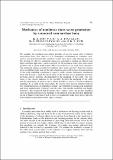Mechanics of nonlinear short-wave generation by a moored near-surface buoy
Author(s)
Zhu, Q.; Liu, Y.; Tjavaras, A.A.; Triantafyllou, M.S.; Yue, D.K.P.
DownloadTriantafyllou_1999_Mechanics.pdf (1.394Mb)
Terms of use
Metadata
Show full item recordAbstract
We consider the nonlinear interaction problem of surface waves with a tethered
near-surface buoy. Our objective is to investigate mechanisms for nonlinear short
surface wave generation in this complete coupled wave-buoy-cable dynamical system.
We develop an effective numerical simulation capability coupling an efficient and
high-resolution high-order spectral method for the nonlinear wave-buoy interaction
problem with a robust implicit finite-difference method for the cable-buoy dynamics.
The numerical scheme accounts for nonlinear wave-wave and wave-body interactions
up to an arbitrary high order in the wave steepness and is able to treat extreme motions
of the cable including conditions of negative cable tension. Systematic simulations
show that beyond a small threshold value of the incident wave amplitude, the buoy
performs chaotic motions, characterized by the snapping of the cable. The root
cause of the chaotic response is the interplay between the snapping of the cable
and the generation of surface waves, which provides a source of strong (radiation)
damping. As a result of this interaction, the chaotic buoy motion switches between
two competing modes of snapping response: one with larger average peak amplitude
and lower characteristic frequency, and the other with smaller amplitude and higher
frequency. The generated high-harmonic/short surface waves are greatly amplified
once the chaotic motion sets in. Analyses of the radiated wave spectra show significant
energy at higher frequencies which is orders of magnitude larger than can be expected
from nonlinear generation under regular motion.
Date issued
1999Department
Massachusetts Institute of Technology. Department of Mechanical EngineeringPublisher
Cambridge University Press
Citation
Journal of Fluid Mechanics, 381, p.305-335 (1999)
Keywords
surface buoy, nonlinear short-wave, numerical simulation